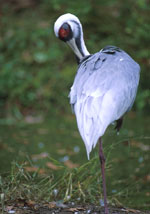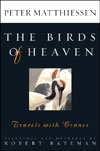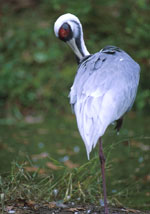What do Nebraska, Ngorongoro, North Korea, Outer Mongolia, England’s Norfolk marshes, and the Australian Outback have in common? The crane — the elegant, long-legged bird that adorns Asian scrolls, appears on bas reliefs at Angkor Wat and in 6,000-year-old Spanish cave paintings, is reproduced in origami and Chinese bronze, and chronicled by Aboriginal, Ainu and Cree storytellers, as well as by Homer, Virgil, Dante, and Aldo Leopold.

Raising crane.
Found on every continent except South America, and most widespread across eastern Asia, the crane began evolving about 40 to 50 million years ago, during the Eocene Epoch. Cranes are among the tallest of flying birds (in some cases, rising to over five feet in height), and most have a striking red cap or feathered crown. They migrate thousands of miles each year at cruising altitudes of one to three miles — it’s easy to understand how these majestic birds became the stuff of legends.
Unfortunately, if current trends persist, cranes may soon exist in art and the imagination only. Of the 15 species that remain today, 11 are threatened or endangered, their numbers depleted by hunting, trapping, poisoning, and — most pervasively — habitat destruction. Given their global range, that cranes are in such trouble is alarming. “Perhaps more than any other living creatures, [cranes] evoke the retreating wilderness, the vanishing horizons of clean water, earth and air upon which their species — and ours, too, though we learn it very late — must ultimately depend for survival,” writes Peter Matthiessen in his persuasive and engaging new book, The Birds of Heaven.

The Birds of Heaven
By Peter Matthiessen
(paintings and drawings
by Robert Bateman)
North Point Press,
349 pages, 2001
Over the past decade or so, Matthiessen — a wildlife expert, conservation advocate, intrepid traveler, and author of over two dozen books — ventured to the far-flung locations where cranes make their home. The Birds of Heaven weaves together tales of expeditions undertaken in the company of fellow “craniacs,” as crane enthusiasts call themselves. While there is probably more crane biology here than many non-craniacs may readily absorb, the book makes a compelling case for cranes’ importance as an indicator of environmental health.
As Matthiessen explains, “Most cranes establish breeding territories in open wetlands or the environs of water.” From the American Midwest to the Mongolian steppe, wetlands worldwide have been systematically drained and destroyed to facilitate agriculture and other development, which further degrades any remaining wetlands. Only in the rare places where human activity has been prevented do wetlands and their dependent species seem to be thriving. Such is the bizarre case of the no-man’s-land between North and South Korea, which Matthiessen calls “the most fiercely protected wildlife sanctuary on earth, and an accidental paradise for cranes.”
Although cranes now benefit from the Korean standoff, they may also be valuable ambassadors of international environmental protection. “How the cranes’ best interests can be reconciled with the national and cultural prejudices of their well-wishers remains the unspoken question,” writes Matthiessen after a crane-watching trip on the Amur River, which runs along the Russian-Chinese border. This will be a particular challenge for China, where, as Matthiessen observes, “Pollution of the earth, air, and water has been largely ignored in the rush toward material consumption that has seized…[that] country in its haste to emulate our shallow and problematical Western ‘progress.'”
Its message is grave, but The Birds of Heaven is pure pleasure to read. Matthiessen’s descriptions of landscape and natural history are deft and eloquent, and his travel stories are peppered with a wry sense of humor. The book’s lyrical prose transports us to some of the least accessible corners of the world and shows us the inextricable connection between the survival of these wild creatures and the homo sapiens who share their turf. “However our own species determines its fate,” writes Matthiessen, “the last great cranes will fly north and south as they have done throughout the long millenniums, all unaware that this strange upright beast whose violent activities have doomed their kind is the only one with the capacity to save them.”



